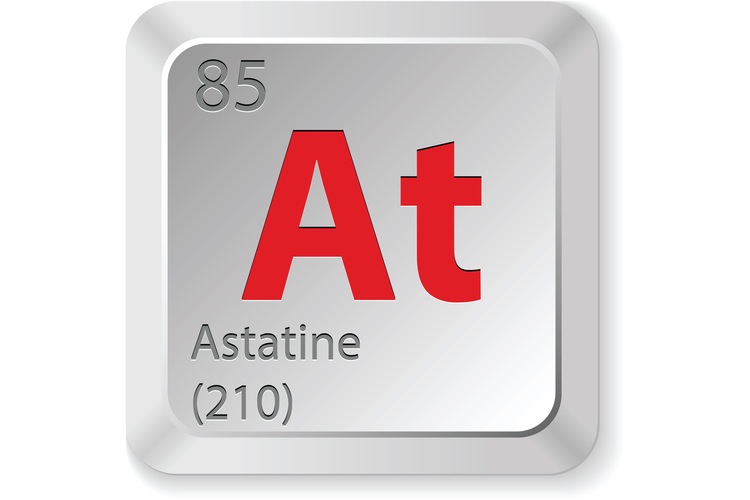Facts About Astatine

Astatine is the rarest element on Earth; only approximately 25 grams occur naturally on the planet at any given time. Its existence was predicted in the 1800s, but was finally discovered about 70 years later. Decades after its discovery, very little is known about astatine. Indeed, physicists infer many of its properties — such as its radioactive properties, conduction and color — based on other halogen group members.
History
Dmitri Mendeleyev, the Russian chemist who in 1869 organized the elements into the periodic table that is still used today, predicted properties of the unknown element that would fill the blank space on the periodic table for element No. 85, according to Peter van der Krogt, a Dutch historian. Mendeleyev named this unknown element eka-iodine due to its position directly below iodine in the halogen group of elements.
As the search for the new element began, several reports were published about element 85, according to a 2010 article published in the Bulletin for the History of Chemistry by Brett F. Thornton and Shawn C. Burdette, researchers in Sweden and the United States, respectively. These reports included claims that the element couldn't exist, that researchers finding the element were unable to isolate it, and that the reported properties were inconsistent with tests.
There is a great deal of ambiguity as to who first discovered astatine, according to Thornton and Burdette. The discovery could be attributed to a handful of researchers, most notably one of the following groups.
The first claim that the mystery element had been discovered was in 1931 by Fred Allison at the Alabama Polytechnic Institute, according to Thornton and Burdette. Allison suggested the name "alabamine" for the new radioactive element that he had discovered. However, as no other researchers were able to replicate his results, and because several faults were found in his equipment, the search for the elusive element continued. Not before, however, the discovery was published in a few student textbooks.
Horia Hulubei and Yvetter Cauchois, researchers at the Sorbonne in Paris, published the results of their discovery of element 85 in 1938. They used chemical separation and published that they found three X-ray spectral lines for the element that closely matched previous predictions. Unfortunately, the breakout of World War II disrupted their research as well as communications among scientists around the world.
The first successfully recognized discovery of astatine was in 1940 by Dale R. Coson, Kenneth Ross Mackenzie and Emilio Segrè, researchers at the University of California Berkeley, according to Chemicool. As no one had been able to find the rare element in nature, this group of scientists artificially produced it by bombarding bismuth-209 with alpha particles in a particle accelerator. This reaction created astatine-211 as well as two free neutrons. The element was highly radioactive and unstable, which led to the name astatine from the Greek word that meant "unstable."
Get the world’s most fascinating discoveries delivered straight to your inbox.
Yet another group of researchers independently identified and characterized element 85 in the early 1940s, according to Thornton and Burdette. Berta Karlik and Traude Bernert in 1942 reported the results of their studies, including the proposed name "viennium." However, because of WWII, the news was kept inside the German territories, and science news from other regions of the world was not brought in, so Karlik and Bernert were not aware of similar results from the Berkeley group. When Karlik and Bernert were made aware of the published results from the group at Berkeley, they still continued to study element 85 and added greatly to the knowledge about the decay chain that forms the element.
Just the facts
- Atomic number (number of protons in the nucleus): 85
- Atomic symbol (on the periodic table of elements): At
- Atomic weight (average mass of the atom): 210
- Density: approximately 4 ounces per cubic inch (approximately 7 grams per cubic cm)
- Phase at room temperature: solid
- Melting point: 576 degrees Fahrenheit (302 degrees Celsius)
- Boiling point: unknown
- Number of natural isotopes (atoms of the same element with a different number of neutrons): at least 30 radioactive isotopes
- Most common isotopes: At-210 (negligible percent of natural abundance), Am-211 (negligible percent of natural abundance)
Who knew?
- Astatine is named after the Greek word 'astatos,' which means unstable, according to the Jefferson Laboratory.
- There are only about 25 grams of naturally occurring astatine in Earth's crust at any given time, according to Chemicool.
- According to Lenntech, astatine is the heaviest known halogen. According to Elemental Matter, halogen elements, including astatine, share similar properties; they are non-metals, have low melting and boiling points, are brittle when solid, are poor conductors of heat and electricity, and are diatomic (their molecules contain two atoms).
- Astatine is the least reactive and has the most metallic properties of any element in the halogen group, according to Chemicool.
- The isotope of astatine with the longest half-life is astatine-210 with a half-life of 8.1 hours, according to the Jefferson Laboratory.
- Many physical properties of astatine are still unknown, including its color, according to a 2013 article by D. Scott Wilbur published in Nature. Based on the color patterns shown by other members of the halogen family, it is believed that astatine is dark, probably close to black.
- Astatine is highly radioactive yet poses nearly no health or environmental effects at all due to its rarity and very short half-lives, according to Lenntech. Although if one does come into contact with it, astatine is thought to accumulate in the thyroid gland similarly to iodine.
Current research
The scarcity of astatine makes it an incredibly difficult element to study. Nevertheless, some researchers think astatine may have uses in treating cancer. Astatine may behave like iodine, which tends to collect in the thyroid gland, according to Chemistry Explained. Astatine may also go to the thyroid, and its radiation could kill cancer cells in the gland.
In a 2015 paper published in the International Journal of Molecular Sciences, a group of French researchers led by Françoise Kraeber-Bodéré describe a radioimmunotherapy (RIT) method of cancer therapy that uses radionuclides that emit either beta or alpha particles. Astatine-211 is one such isotope that could be beneficial to alpha therapy because it has a longer half-life than traditionally used bismuth-213, and it can be produced in particle accelerators. Astatine-211 has been studied for this use since at least 1989, according to the authors, and has shown to have promising results, including trials with bone marrow transplants in leukemia patients, stem cell transplantation studies in mice, and in chemotherapy treatments with patients with brain tumors.
The conclusions reached by the researchers shows that using a radioactive isotope, such as astatine-211, can improve RIT efficiency for treating tumors and other cancers, especially if treatment is started early in the disease. This method of RIT also has the potential to kill remaining tumor cells that are typically resistant to chemo and radioactive therapy.
Additional resources

Rachel Ross is a science writer and editor focusing on astronomy, Earth science, physical science and math. She holds a Bachelor of Arts in Philosophy from the University of California Davis and a Master's degree in astronomy from James Cook University. She also has a certificate in science writing from Stanford University. Prior to becoming a science writer, Rachel worked at the Las Cumbres Observatory in California, where she specialized in education and outreach, supplemented with science research and telescope operations. While studying for her undergraduate degree, Rachel also taught an introduction to astronomy lab and worked with a research astronomer.


